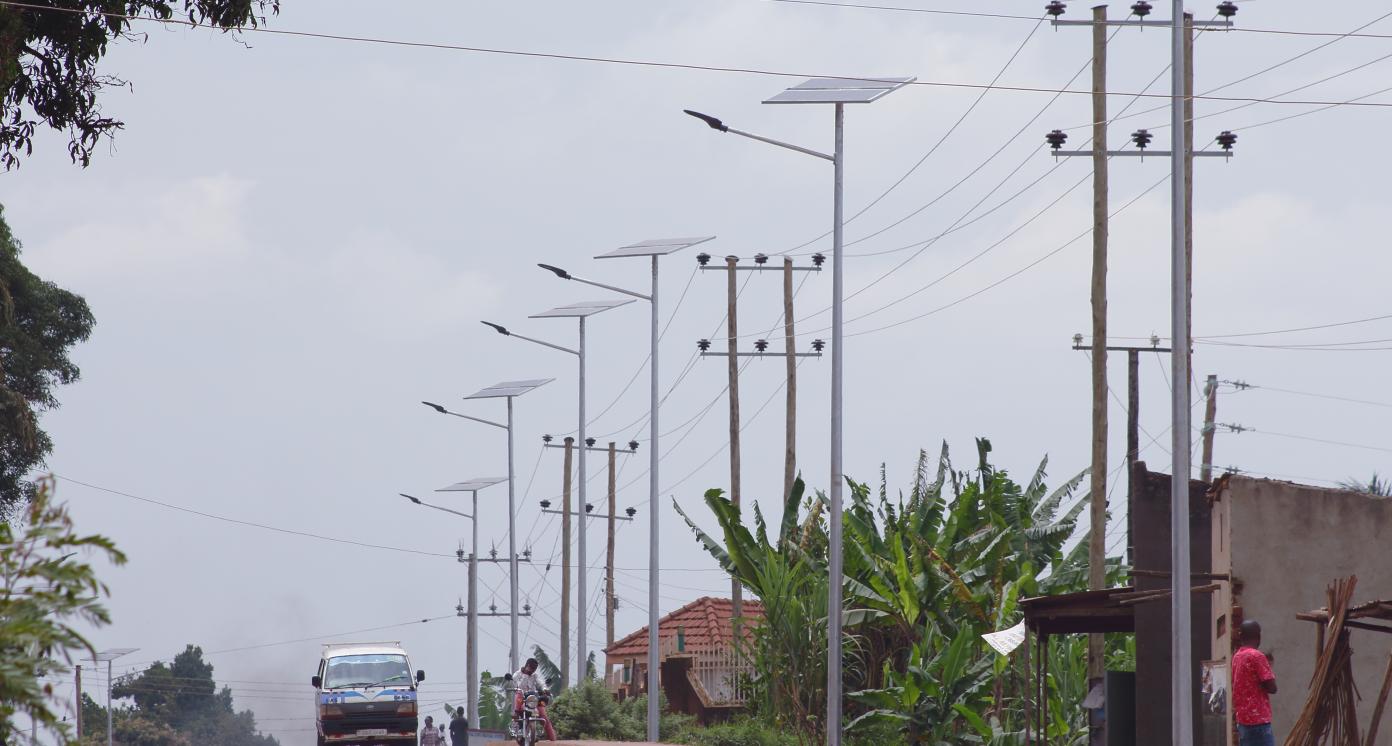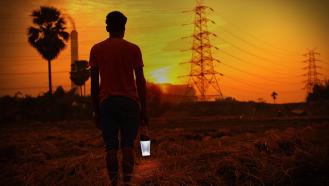Solar-powered appliances





Business Model Description
Manufacture and / or assemble energy efficient solar appliances, such as lamps, water heaters or stoves, for large-scale public and private buildings, such as hospitals, schools and offices.
Expected Impact
Equip critical public infrastructure in remote areas with access to clean, reliable and cost-effective electricity.
How is this information gathered?
Investment opportunities with potential to contribute to sustainable development are based on country-level SDG Investor Maps.
Disclaimer
UNDP, the Private Finance for the SDGs, and their affiliates (collectively “UNDP”) do not seek or solicit investment for programmes, projects, or opportunities described on this site (collectively “Programmes”) or any other Programmes, and nothing on this page should constitute a solicitation for investment. The actors listed on this site are not partners of UNDP, and their inclusion should not be construed as an endorsement or recommendation by UNDP for any relationship or investment.
The descriptions on this page are provided for informational purposes only. Only companies and enterprises that appear under the case study tab have been validated and vetted through UNDP programmes such as the Growth Stage Impact Ventures (GSIV), Business Call to Action (BCtA), or through other UN agencies. Even then, under no circumstances should their appearance on this website be construed as an endorsement for any relationship or investment. UNDP assumes no liability for investment losses directly or indirectly resulting from recommendations made, implied, or inferred by its research. Likewise, UNDP assumes no claim to investment gains directly or indirectly resulting from trading profits, investment management, or advisory fees obtained by following investment recommendations made, implied, or inferred by its research.
Investment involves risk, and all investments should be made with the supervision of a professional investment manager or advisor. The materials on the website are not an offer to sell or a solicitation of an offer to buy any investment, security, or commodity, nor shall any security be offered or sold to any person, in any jurisdiction in which such offer would be unlawful under the securities laws of such jurisdiction.
Country & Regions
- Uganda: Acholi
- Uganda: West Nile
- Uganda: Western
- Uganda: Karamoja
Sector Classification
Renewable Resources and Alternative Energy
Development need
Uganda has significant unexploited renewable resources to produce energy and provide energy services.(I) Energy consumption in Uganda is estimated to be at 75 kilowatts per hour (kWh) per capita, which is considerably lower than Africa’s and the world's respective average of 578 kWh per capita and 2472 kWh per capita.(I)
Policy priority
The government plans to increase access to energy from 21% to 60% by 2025, increase generation capacity from 3,000 to 3,500 megawatts (MW) and reduce electricity price from USD 0.08 to USD 0.05.(III)
Key bottlenecks introduction
In Uganda, the renewable energy industry faces various challenges, including high upfront costs of technology (e.g. solar and development of small hydro power plants) and limited financial resources for investment in large infrastructure energy projects.(I)
Solar Technology and Project Developers
Pipeline Opportunity
Solar-powered appliances
Manufacture and / or assemble energy efficient solar appliances, such as lamps, water heaters or stoves, for large-scale public and private buildings, such as hospitals, schools and offices.
Business Case
Market Size and Environment
More than 20 million people did not have access to electricity in 2018.
In 2018, 62% of the rural population did not have access to electricity, accounting for more than 20 million people.(17)
The demand for electricity in Uganda is rapidly growing by 10-12% annually (5), which shows the sector's potential for investment.
Uganda's potential electrical capacity is estimated at approximately 200 megawatts (MW).(5) The market is gaining momentum, with more than 30,000 solar photovoltaic (PV) systems already being installed in the country in rural areas and two PV plants in the planning stage.(5)
Indicative Return
20% - 25%
Benchmark statistics for the appliance manufacturing sector estimate a return rate of 18.6% to 22.6%. This rate is a benchmark calculated as a cost of equity with a country risk premium, reflecting an average return required by investors.(21)
Investment Timeframe
Medium Term (5–10 years)
The timeframe for this investment area should be considered medium term, given the most advanced technological parts must be imported. However, the investment timeframe depends on the quantity and size of the solutions deployed.(1)
Market Risks & Scale Obstacles
Market - Highly Regulated
Capital - Limited Investor Interest
Capital - high cost of financing
Impact Case
Sustainable Development Need
Uganda has one of the lowest electricity consumption per capita rates in the world.(5) In 2017, 42% of Uganda's population had access to electricity.(17)
In 2016, only 0.8% of the population had access to clean fuels and technology for cooking.(17)
Low-grade forms of energy (in particular traditional biomass fuels) constitute over 90% of total energy consumption in Uganda.(5) This also negatively affects the health of people living in houses where this kind of energy source is being used.
Gender & Marginalisation
There is a discrepancy between rural and urban areas. While only 38% of the population living outside the city had access to electricity in 2018, more than half (57%) of urban inhabitants had it in the same year.(17)
Expected Development Outcome
Increased access to electricity and heated water for household use, improved agricultural opportunities, employment creation for unemployed / underemployed youth
Increased household incomes due to increased opportunities and productivity, increased agricultural productivity for farmers, improved learning opportunities for children
Improved and more reliable healthcare delivery, reliable power supply in federal universities and university teaching hospitals in remote areas
Gender & Marginalisation
Increased access and higher reliability especially regarding education, employment and health opportunities, for women and children
Primary SDGs addressed

7.1.1 Proportion of population with access to electricity
7.2.1 Renewable energy share in the total final energy consumption
7.3.1 Energy intensity measured in terms of primary energy and GDP
7.b.1 Installed renewable energy-generating capacity in developing countries (in watts per capita)

13.b.1 Number of least developed countries and small island developing States with nationally determined contributions, long-term strategies, national adaptation plans, strategies as reported in adaptation communications and national communications
Secondary SDGs addressed



Directly impacted stakeholders
People
Gender inequality and/or marginalization
Planet
Corporates
Public sector
Outcome Risks
Storage and disposal of used photovoltaic (PV) panels can be harmful to the health of people and the planet (15)
Impact Classification
What
Positive impact because it will increase productivity and inclusion, by enabling access to electricity which will ultimately reduce carbon footprints and greenhouse gas emissions
Who
Households, micro, small and medium enterprises and public institutions (schools, health facilities, etc.) in remote areas that are constrained by either non-existent or unstable electricity supply.
Risk
Public procurement, community mistrust, low consumer buy-in and access to financing may pose a risk to the investment.
Impact Thesis
Equip critical public infrastructure in remote areas with access to clean, reliable and cost-effective electricity.
Enabling Environment
Policy Environment
Energy and Mineral Sector Development Plan 2015/16 – 2019/20: This plan describes the challenges of the energy sector and government's targets for electrification. It also lists publicly procured programs aimed at improving access to electricity.(6)
Renewable Energy Policy 2007: This policy aimed to increase the use of modern renewable energy in the total energy consumption from 4% in 2007 to 61% by 2017.(7)
Draft National Energy Policy: This policy identifies new targets for electrification and government programs that support sector development.(8)
Additionally, the Climate Change Policy (2015) supports the energy policy by promoting and developing new clean energy technologies to reduce greenhouse gas emissions, as part of the government's commitment to reduce emissions by 22% by 2030.(8)
National Industrial Policy: This policy outlines the constraints and challenges in the manufacturing sector together with solutions and government interventions. It also identifies priority investments necessary to develop industry and manufacturing in Uganda.(22)
Financial Environment
Fiscal incentives: Specialised equipment for developing and generating solar energy are exempted from taxes under the 5th schedule of the East African Community Customs Management Act 2004.(12) Inputs used to produce solar panels are subject to remission of import duty rate 0%.(12)
Regulatory Environment
Electricity Act 1999: This Act regulates generation, transmission, distribution, sale and use of electricity, as well as licensing and control of activities in the electricity sector. It provides for plant and equipment and for matters relating to safety.(9)
Collective Investment Schemes (Conduct of Business and Miscellaneous Provisions) Regulations 2007: These regulations provide requirements for communications, responsibilities and compliance and reporting by investors.(13)
National Standards and Quality Policy 2012: The policy provides the framework for standardisation and maintenance of high quality of products.(14) A list of compulsory and voluntary standards is available in the Uganda Standards Catalogue issued by the Uganda National Bureau of Standards. (23)
The Ministry of Energy and Mineral Development is responsible for all policymaking and regulatory activities in the energy sector in Uganda.(18) The Electricity Regulatory Authority licenses and supervises all actors in Uganda's energy industry.(19)
Marketplace Participants
Private Sector
African Clean Energy, Solar Now, Solar Energy for Africa
Government
Ministry of Energy and Mineral Development, Uganda Solar Energy Association (USEA), Uganda National Renewable Energy and Energy Efficiency Alliance (UNREEEA)
Multilaterals
World Bank, International Finance Corporation (IFC), Enhanced Integrated Framework (EIF)
Non-Profit
African Development Bank (AfDB), Government Corporation for International Cooperation (GIZ), Energy Sector Management Assistance Program (ESMAP)
Target Locations
Uganda: Acholi
Uganda: West Nile
Uganda: Western
Uganda: Karamoja
References
- (I) Ministry of Energy and Mineral Development. Energy and Mineral Development Sector Development Plan 2015/16 – 2019/20. (II) Sachs, J., Schmidt-Traub, G., Kroll, C., Lafortune, G., Fuller, G., Woelm, F. (2020). The Sustainable Development Goals and COVID-19. Sustainable Development Report 2020. Cambridge: Cambridge University Press. (III) National Planning Authority. National Development Plan III (NDPIII) 2020/21 – 2024/25.
- (1) German Energy Solutions (2018). Presentation on Nigeria’s off-grid renewable energy market and investment potentials. https://www.german-energy-solutions.de/GES/Redaktion/DE/Publikationen/Praesentationen/2018/181120-iv-nigeria-ohiahre-rea.pdf?__blob=publicationFile&v=3
- (2) Sachs, J., Schmidt-Traub, G., Kroll, C., Lafortune, G., Fuller, G., Woelm, F. (2020). The Sustainable Development Goals and COVID-19. Sustainable Development Report 2020. Cambridge: Cambridge University Press.
- (3) Uganda National Renewable Energy and Energy Efficiency Alliance. Overview of Uganda’s Renewable Energy Potential. https://unreeea.org/resource-center/overview-of-the-ugandan-energy-sector/
- (4) United States Agency for International Development (2016). Power Africa in Uganda. https://www.usaid.gov/sites/default/files/documents/1860/UgandaCountryFactSheet.2016.09_FINAL.pdf
- (5) Mokveld, K. and von Eije (RVO.nl), S. (2019). Final Energy report Uganda. https://www.rvo.nl/sites/default/files/2019/02/Final-Energy-report-Uganda.pdf
- (6) Ministry of Energy and Mineral Development. Energy and Mineral Sector Development Plan 2015/16 – 2019/20.
- (7) Ministry of Energy and Mineral Development (200&). Renewable Energy Policy For Uganda. https://etutoring.gayazahs.sc.ug/uploads/ebooks/1336063700.pdf
- (8) Ministry of Energy and Mineral Development (2019). Draft National Energy Policy. http://energyandminerals.go.ug/site/assets/files/1081/draft_revised_energy_policy_-_11_10_2019-1_1.pdf
- (9) Government of Uganda (1999). Electricity Act. https://uegcl.com/about/electricity-act/file.html
- (10) Global Energy Network Institute. National Energy Grid Uganda. http://www.geni.org/globalenergy/library/national_energy_grid/uganda/ugandannationalelectricitygrid.shtml]
- (11) Energypedia. Uganda Energy Situation. https://energypedia.info/wiki/Uganda_Energy_Situation
- (12) Uganda Revenue Authority (2019). A Tax Incentives Guide for Investors in Uganda. https://www.ebiz.go.ug/wp-content/uploads/2020/03/TAX_INCENTIVES_GUIDE_FOR_INVESTORS_IN_UGANDA_October_2019.pdf
- (13) Government of Uganda (2007). The Collective Investment Schemes (Conduct of Business and Miscellaneous Provisions) Regulations. https://businesslicences.go.ug/kcfinder/upload/files/The%20Collective%20Investment%20Schemes%20%28Conduct%20of%20business%20and%20misc.%20provisions%29%20Regulations%2C%202007.pdf
- (14) Ministry of Trade, Industry and Cooperatives (2012). National Standards and Quality Policy. http://www.mtic.go.ug/wp-content/uploads/2019/08/National-Standards-and-Quality-Policy.pdf
- (15) Bielecki, A., Ernst, S., Skrodzka, W. and Wojnicki, I. (2020). The externalities of energy production in the context of development of clean energy generation. https://link.springer.com/article/10.1007/s11356-020-07625-7
- (16) Guangul, F.M. and Chala, G.T. (2019). Solar Energy as Renewable Energy Source: SWOT Analysis. https://www.researchgate.net/publication/331266856_Solar_Energy_as_Renewable_Energy_Source_SWOT_Analysis
- (17) World Bank database.
- (18) Ministry of Energy and Mineral Development. About Us. https://www.energyandminerals.go.ug/about-us/
- (19) Electricity Regulatory Authority (2018). Functions of ERA. https://www.era.go.ug/index.php/about-us/era/functions
- (20) Rural Electrification Agency. REA Profile Overview. http://www.rea.or.ug/index.php/about-us/
- (21) PwC analysis based on Prof. A. Damodaran data, 2020.
- (22) Ministry of Tourism, Trade and Industry (2008). National Industrial Policy. http://www.mtic.go.ug/wp-content/uploads/2019/08/National-Industrial-Policy.pdf
- (23) Uganda National Bureau of Standards (2020). Uganda Standards Catalogue as at 30 June 2020. https://unbs.go.ug//attachments/menus/27/Uganda%20Standards%20Catalogue%20as%20at%2030%20June%202020-Final-2020-10-25.pdf
















